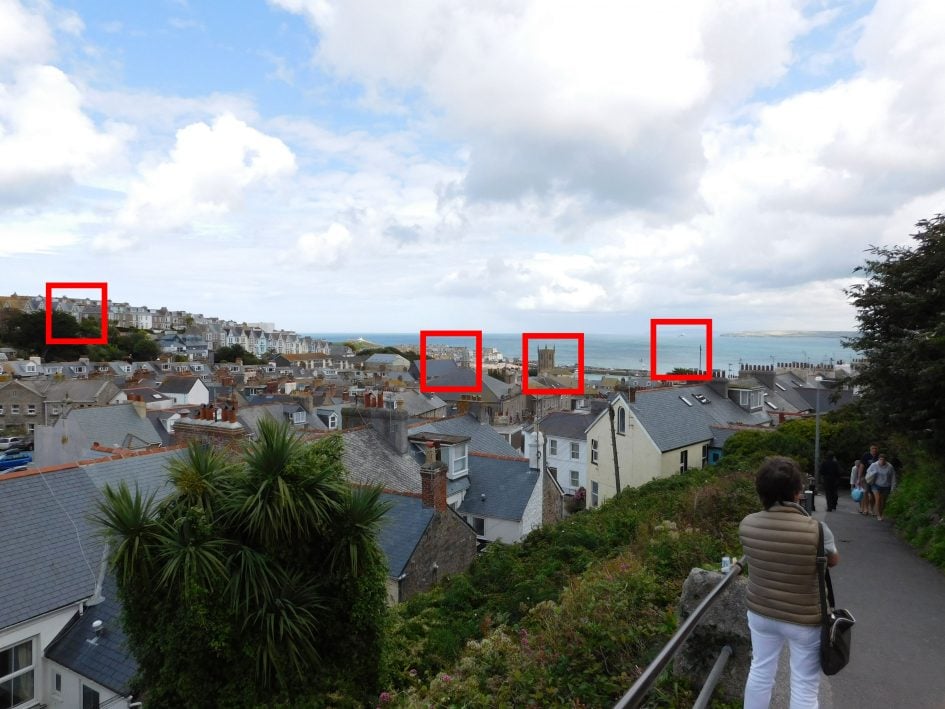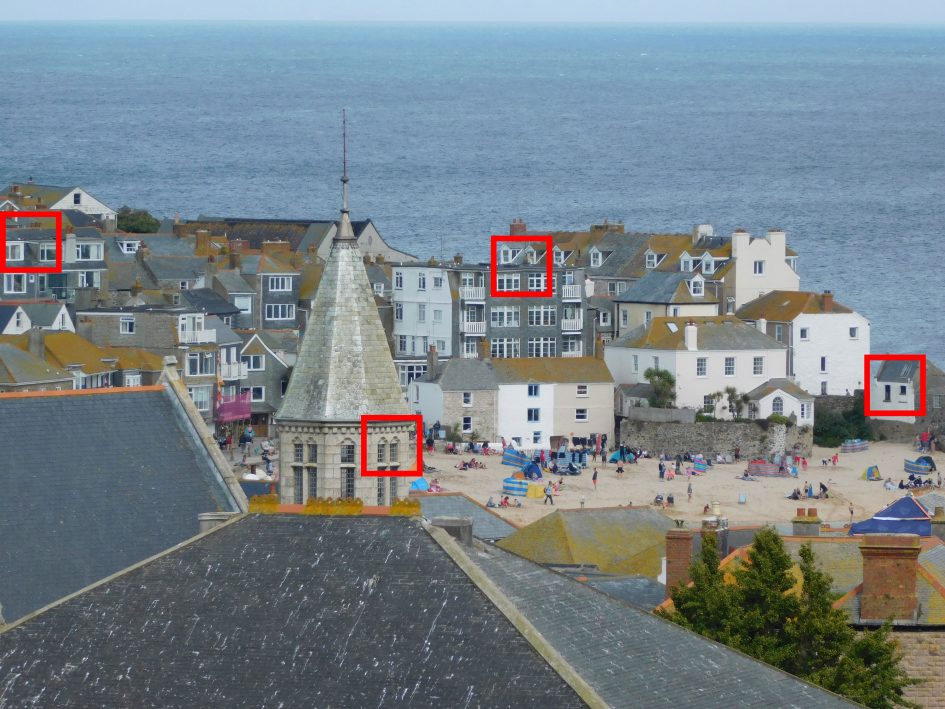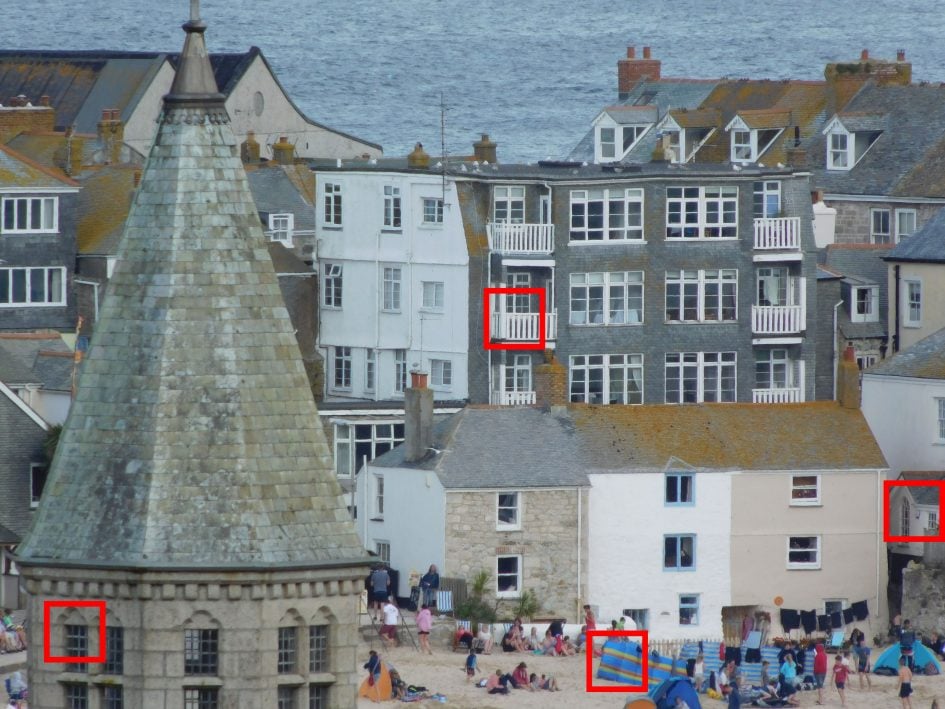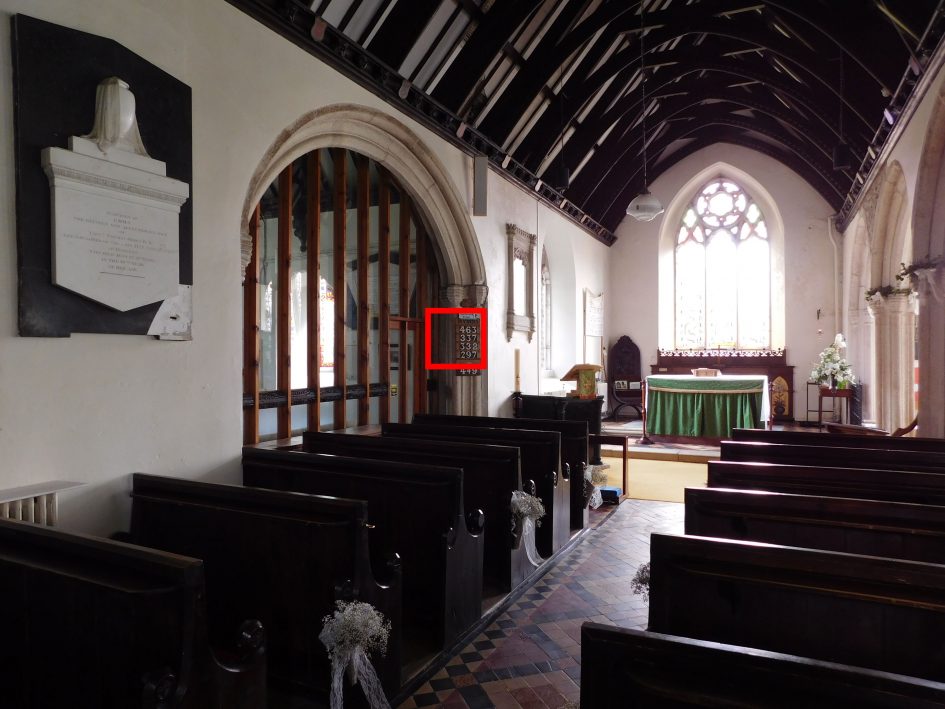Nikon COOLPIX L840 review
-
-
Written by Ken McMahon
Quality
Nikon COOLPIX L840 vs Canon PowerShot SX410 IS vs SX530 HS quality
To compare real-life performance, I shot this scene with the Nikon COOLPIX L840, Canon PowerShot SX410 IS and Canon PowerShot SX530 HS, within a few moments of each other, using their best quality JPEG settings and at their base sensitivity settings. For this test the cameras were mounted on a tripod and image stabilisation was disabled. The cameras were zoomed in to provide the same field of view, the ISO sensitivity was manually set to the lowest available setting and Program Auto mode was selected for the exposure.
At its base 125 ISO setting the COOLPIX L840 selected an exposure of 1/100 at f3. At 100 ISO the PowerShot SX410 IS chose 1/800 at f4 and the PowerShot SX530 HS set 1/640 at f4 also at 100 ISO.
At first glance the crops from the COOLPIX L840 look a little bit noisy. The first crop in particular looks a little clumpy and there’s not as much fine detail as there could be in the houses in the top half of the frame. The second crop looks a little better though, you can make out quite a bit of detail in the distant houses and the edges of the window frames are clean and distinct. The third crop isn’t bad and you can see some detail in the church tower, again though, there’s more that you’re not seeing and the detail in the harbour beyond the church looks a little clumpy.
Finally, the lighthouse crop again has some noise texture, but the lighthouse itself is distinct, and you can see some detail in the rocks as well as the foreground. Overall I’d say this is an average result for the COOLPIX L840, good, but not outstanding. The other sense in which it’s average is that it’s substantially better than the results from the 20 Megapixel Canon PowerShot SX410 IS, but not quite up to the standards of the PowerShot SX530 HS.
Scroll down to see how these models compare at the middle of their zoom ranges and when fully zoomed in. To find out how they compare at higher sensitivities head for my Nikon L840 noise results, skip to my Nikon L840 sample images, or head straight to my verdict.
Above left: Nikon COOLPIX L840 at 4.1mm (24mm equivalent) f3, 125 ISO. Above center: Canon PowerShot SX410 IS at 4.3mm (24mm equivalent) f4, 100 ISO. Above right: Canon PowerShot SX530 HS at 4.3mm (24mm equivalent) f4, 100 ISO.
Above left: Nikon COOLPIX L840 at 4.1mm (24mm equivalent) f3, 125 ISO. Above center: Canon PowerShot SX410 IS at 4.3mm (24mm equivalent) f4, 100 ISO. Above right: Canon PowerShot SX530 HS at 4.3mm (24mm equivalent) f4, 100 ISO.
Above left: Nikon COOLPIX L840 at 4.1mm (24mm equivalent) f3, 125 ISO. Above center: Canon PowerShot SX410 IS at 4.3mm (24mm equivalent) f4, 100 ISO. Above right: Canon PowerShot SX530 HS at 4.3mm (24mm equivalent) f4, 100 ISO.
Above left: Nikon COOLPIX L840 at 4.1mm (24mm equivalent) f3, 125 ISO. Above center: Canon PowerShot SX410 IS at 4.3mm (24mm equivalent) f4, 100 ISO. Above right: Canon PowerShot SX530 HS at 4.3mm (24mm equivalent) f4, 100 ISO.
Nikon COOLPIX L840 vs Canon PowerShot SX410 IS vs Canon PowerShot SX530 HS quality at 300mm equivalent
The image above was taken with the Nikon COOLPIX L840 zoomed in to around 300mm equivalent. As before the camera was mounted on a tripod with the stabilisation turned off and the exposure was set automatically. The crops are taken from the areas marked in red.
At this mid range focal length the first and final crops from the COOLPIX L840 look a little softer than crops two and three which are from closer to the middle of the frame. The other thing to note here is the purple colour fringing in the final crop, a result of chromatic aberration, a lens failing which you’d expect would be corrected for as part of the camera’s software processing of JPEG images. That’s most likely why you can’t see the same problem in the crops from the PowerShot SX410 IS and SX530 HS.
There’s still more detail visible in the PowerShot SX530 HS crops, but I’d say, at this focal length at least, there’s very little between the SX410 IS and the COOLPIX L840.
Above left: Nikon COOLPIX L840 at 59mm (335mm equivalent) f5.8, 125 ISO. Above center: Canon PowerShot SX410 IS at 56mm (312mm equivalent) f5.6, 100 ISO. Above right: Canon PowerShot SX530 HS at 54mm 301mm equivalent) f5.6, 100 ISO.
Above left: Nikon COOLPIX L840 at 59mm (335mm equivalent) f5.8, 125 ISO. Above center: Canon PowerShot SX410 IS at 56mm (312mm equivalent) f5.6, 100 ISO. Above right: Canon PowerShot SX530 HS at 54mm 301mm equivalent) f5.6, 100 ISO.
Above left: Nikon COOLPIX L840 at 59mm (335mm equivalent) f5.8, 125 ISO. Above center: Canon PowerShot SX410 IS at 56mm (312mm equivalent) f5.6, 100 ISO. Above right: Canon PowerShot SX530 HS at 54mm 301mm equivalent) f5.6, 100 ISO.
Above left: Nikon COOLPIX L840 at 59mm (335mm equivalent) f5.8, 125 ISO. Above center: Canon PowerShot SX410 IS at 56mm (312mm equivalent) f5.6, 100 ISO. Above right: Canon PowerShot SX530 HS at 54mm 301mm equivalent) f5.6, 100 ISO.
Nikon COOLPIX L840 vs Canon PowerShot SX410 IS vs Canon PowerShot SX530 HS quality at 855mm equivalent
For this final test, I zoomed all three cameras in to around 855mm equivalent to match the maximum focal length of the Nikon COOLPIX L840. This is just a tad short of the 960mm maximum zoom range of the SX410 IS (100mm may sound like a lot, but is actually a small difference in terms of field of view at this focal length). The PowerShot SX530 HS on the other hand has a significantly longer maximum focal length of 1200mm equivalent. Once consequence of this that’s worth noting is that while the PowerShot SX410 IS and COOLPIX L840 maximum aperture’s are f6.3 and f6.5 respectively, the PowerShot SX530 HS can manage nearly a half stop brighter at f5.6.
The story here is much the same as at the other end of the zoom range, the crops from the PowerShot SX530 HS are a tiny bit softer than those from the SX410 IS, but there’s less noise and though it’s smaller the detail is sharper. So it’s a clear win on image quality terms for the SX530 HS, with the Nikon COOLPIX L840 in second place and the noisier PowerShot SX410 IS third. As always though, it’s worth bearing in mind that these differences only reveal themselves at, or close to, 100 percent viewing sizes, so unless you plan on making big prints image quality may not be a major influence on your buying decision. There’s also inevitably some softness overall here due to atmospheric disturbances.
To find out how they compare at higher sensitivities scroll for my Nikon COOLPIX L840 noise results, skip to my Nikon COOLPIX L840 sample images, or head straight to my verdict.
Above left: Nikon COOLPIX L840 at 152mm (855mm equivalent) f6.5, 125 ISO. Above center: Canon PowerShot SX410 IS at 150mm (840mm equivalent) f6.3, 100 ISO. Above right: Canon PowerShot SX530 HS at 152mm 848mm equivalent) f5.6, 100 ISO.
Above left: Nikon COOLPIX L840 at 152mm (855mm equivalent) f6.5, 125 ISO. Above center: Canon PowerShot SX410 IS at 150mm (840mm equivalent) f6.3, 100 ISO. Above right: Canon PowerShot SX530 HS at 152mm 848mm equivalent) f5.6, 100 ISO.
Above left: Nikon COOLPIX L840 at 152mm (855mm equivalent) f6.5, 125 ISO. Above center: Canon PowerShot SX410 IS at 150mm (840mm equivalent) f6.3, 100 ISO. Above right: Canon PowerShot SX530 HS at 152mm 848mm equivalent) f5.6, 100 ISO.
Above left: Nikon COOLPIX L840 at 152mm (855mm equivalent) f6.5, 125 ISO. Above center: Canon PowerShot SX410 IS at 150mm (840mm equivalent) f6.3, 100 ISO. Above right: Canon PowerShot SX530 HS at 152mm 848mm equivalent) f5.6, 100 ISO.
Nikon COOLPIX L840 vs Canon PowerShot SX410 IS vs SX530 HS noise
To compare noise levels under real-life conditions, I shot this scene with the Nikon COOLPIX L840, the Canon PowerShot SX410 IS and the Canon PowerShot SX530 HS, within a few moments of each other at each of their ISO settings. All three cameras were set to their best quality JPEG modes and mounted on a tripod and stabilisation was disabled.
The cameras were zoomed in to provide the same field of view, the ISO sensitivity was manually set to the lowest available setting and Auto mode was selected for the exposure.
With the sensitivity manually set to 125 ISO the COOLPIX L840 selected an exposure of 1/5 at f3. Both PowerShots were set to their base 100 ISO setting where the PowerShot SX410 IS chose an exposure of 0.4s at f3.5 and the PowerShot SX530 HS set an exposure of 0.4s at f3.4. The crops below are selected from the area marked in red above.
The first crop from the COOLPIX L840 at its base 125 ISO sensitivity shows some evidence of noise, but even at 100 percent it’s not that intrusive. Having said that the noise is interfering with ability of the COOLPIX L840’s sensor to resolve finer image detail – as you can see from the text on the white label at the top of the hymn board.
As you’d expect, the noise gets progressively worse as you increase the ISO sensitivity, but up to 400 ISO it’s managed fairly well by the COOLPIX L840’s noise reduction algorithms. Even at 800 ISO the COOLPIX L840’s images look good enough to print at or close to 100 percent viewing sizes. At 1600 ISO though things begin to look a little ugly. The COOLPIX L840 deals with noise in a different way to the Canon PowerShots. Where the higher ISO crops from the PowerShot SX410 IS and SX530 HS have a salt and pepper graininess, the detail in the COOLPIX L840 is coarse and clumpy.
The COOLPIX L840 range extends to 6400 ISO, a specification that may look impressive on paper but has little to offer in practice. As on the PowerShot SX530 HS, the 3200 ISO setting is arguably useful for taking shots in very low light that you’d want to have regardless of the quality, but 6400 ISO is more noise than image data and a step too far.
The COOLPIX L840’s sensor shares the same 16 Megapixel resolution as the PowerShot SX530 HS’s and both are CMOS sensors. Both sets of crops look very similar in terms of noise, though, as I’ve mentioned the COOLPIX high ISO crops look clumpier. While there’s little difference in the noise output of the two sensors bear in mind what I’ve previously mentioned about Aperture priority on the SX530 HS providing the opportunity to set a lower ISO.
The PowerShot SX410 IS’s 20 Megapixel CCD sensor produces a smaller crop area with larger detail than the 16 Megapixel sensors of the COOLPIX L840 and PowerShot SX530 HS . As with the outdoor test results, the 100 ISO crops from the PowerShot SX410 IS looks quite noisy. The noisier base level and the larger noise increments – mean that the PowerShot SX410 IS crops are all noisier throughout the range than those from the COOLPIX L840 and PowerShot SX530 HS. But while the gap is relatively small at the lower end of the range by 400 ISO I’d say there’s a one stop difference – in other words the 400 ISO crop from the SX410 IS looks similar to the 800 ISO crop from the COOLPIX L840.
Above left: Nikon COOLPIX L840 at 125 ISO. Above center: Canon PowerShot SX410 IS at 100 ISO. Above right: Canon PowerShot SX530 HS at 100 ISO.
Above left: Nikon COOLPIX L840 at 200 ISO. Above center: Canon PowerShot SX410 IS at 200 ISO. Above right: Canon PowerShot SX530 HS at 200 ISO.
Above left: Nikon COOLPIX L840 at 400 ISO. Above center: Canon PowerShot SX410 IS at 400 ISO. Above right: Canon PowerShot SX530 HS at 400 ISO.
Above left: Nikon COOLPIX L840 at 800 ISO. Above center: Canon PowerShot SX410 IS at 800 ISO. Above right: Canon PowerShot SX530 HS at 800 ISO.
Above left: Nikon COOLPIX L840 at 1600 ISO. Above center: Canon PowerShot SX410 IS at 1600 ISO. Above right: Canon PowerShot SX530 HS at 1600 ISO.
Above left: Nikon COOLPIX L840 at 3200 ISO. Above center: Canon PowerShot SX410 IS 3200 ISO not available. Above right: Canon PowerShot SX530 HS at 3200 ISO.
Above left: Nikon COOLPIX L840 at 6400 ISO. Above center: Canon PowerShot SX410 IS 6400 ISO not available. Above right: Canon PowerShot SX530 HS6400 ISO not available.



























